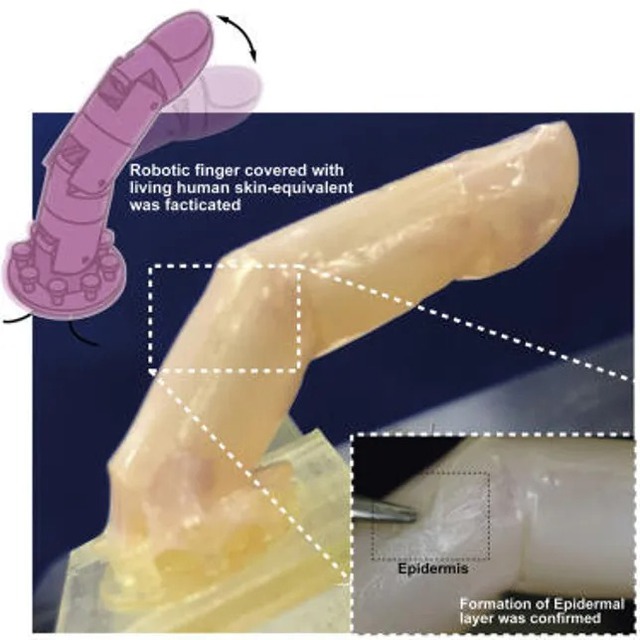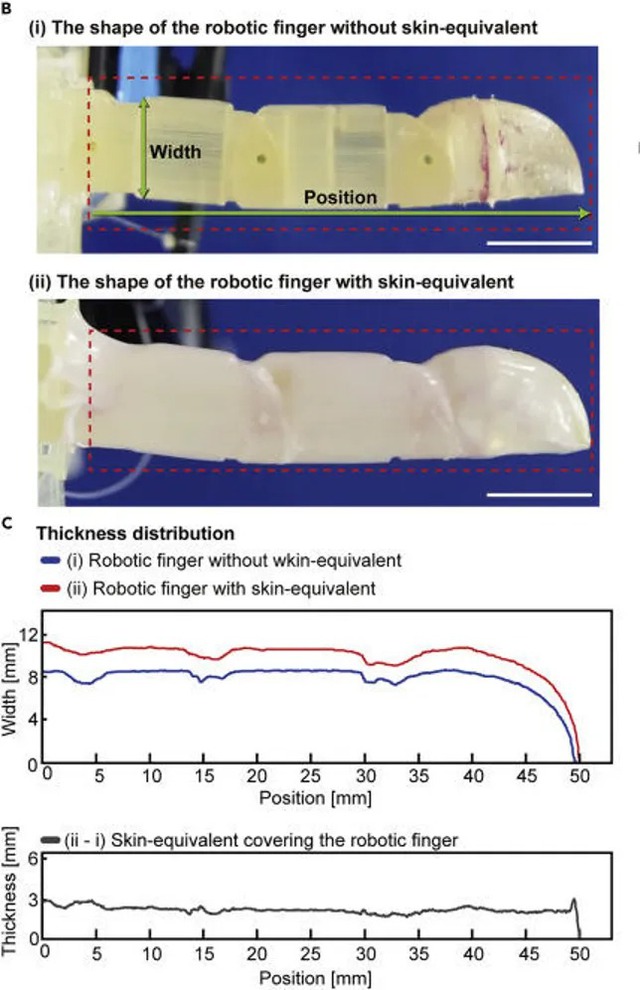Scientists successfully make ‘living skin’ for robots from human cells
If scientists want to bring humanoid robots to society, they will need to create artificial versions of every feature on the human body. Then they would have to sum them all together. This is a very difficult challenge. But, we can simplify the work by grouping things into two main categories.
First, it’s the mental aspect. Things like consciousness, autonomy, imagination and perhaps bodily reflexes. Second, are physical things. It includes flexible movement, eye control, normal gait, and most importantly, skin.
Human skin is soft, supple, elastic and has the characteristics of each individual’s sweat, which is not easy to reproduce.
But yesterday, June 9, in the scientific journal Matter, Japanese scientists announced that they had made some progress in this regard. Specifically, they have successfully built a robotic finger covered with “raw skin”, or a prototype skin. And it’s made from real human cells.

The team’s new robotic finger is covered with ‘raw skin’.
Shoji Takeuchi, a professor at the University of Tokyo, said: “I think raw skin is the optimal solution to give the robot the look and feel of a living organism because it is exactly like the covering material on an animal’s body.”
The material not only resembles and feels like human skin, but the team says that because it’s made from real skin cells, it’s also self-healing and waterproof. Attached to the robot, the skin is therefore able to repair its own cuts and scrapes, just like normal human skin.
However, although Professor Takeuchi said that the research team had “surprised how well the skin tissue fits the surface of the robot”he still added that “This is just the first step towards creating a robot covered in raw skin.”
The newly developed robotic skin is still not quite as healthy as natural skin and needs outside help to be able to maintain itself. Furthermore, the team also intends to add hair follicles, fingernails and sweat glands to make it more lifelike.

The image shows the robot finger with and without skin.
However, looking like is one thing. Simulating all the features of real leather is a much more difficult challenge. This is a conundrum that requires researchers to go beyond conventional norms, and go in a different direction.
For example, silicone skin cannot create subtle shades such as flexible pores or age wrinkles. It also has a ceiling limit on reproducibility. And Professor Takeuchi says other attempts to create human skin have had limited success because they require skilled artisans to cut and adjust lab-grown skins to fit. with robotic fingers.
“In order to effectively cover surfaces with skin cells, we established a tissue molding method to directly mold the skin tissue around the robot, resulting in a seamless overlay of skin on a robotic finger.” , Mr. Takeuchi said.
How to make skin for humanoid robot
Essentially, the team took a standard robotic finger, and then dipped it into a cylinder filled with a special solution that created the right conditions for growing raw skin.
The solution is filled with collagen, a protein that helps increase skin elasticity and firmness, as well as what’s known as “human skin fibroblasts”. These fibroblasts are the same skin cells that the researchers used. Together, these two components are similar in texture to traditional skin tissue in the human body.
Next, the mixture of collagen and fibroblasts contracts around the robotic finger, covering it like a skin primer. This is the first layer of skin.
In the second layer, the scientists replaced fibroblasts with a new type of cell called human epidermal keratinocytes, which make up about 90 percent of the outermost layer of skin in our bodies. Finally, when the keratinocytes adhere to the stroma of fibroblasts, the mechanism is nearly complete. The robotic finger already has skin.

A diagram showing the development of the robot’s skin.
“Fingers look a bit ‘sweat’ out of culture,” Professor Takeuchi said and added that “Since the finger is driven by an electric motor, it’s also interesting to hear the click of the motor in harmony with the real-looking finger.”
And while the team’s prototype is still in its early stages – it still needs outside help to stay self-sustaining and regenerative – it could be a promising step forward for world robots. next system. In fact, the team even suggests that their concept of raw skin could one day delve into the spiritual side of humanoid robot building. For example adding sensory neurons.
In other words, they think there might be a way to create a robotic brain in the future. However, creating a human-like robotic brain is arguably the greatest of all the challenges of human science.
Refer Cnet
at Blogtuan.info – Source: genk.vn – Read the original article here


